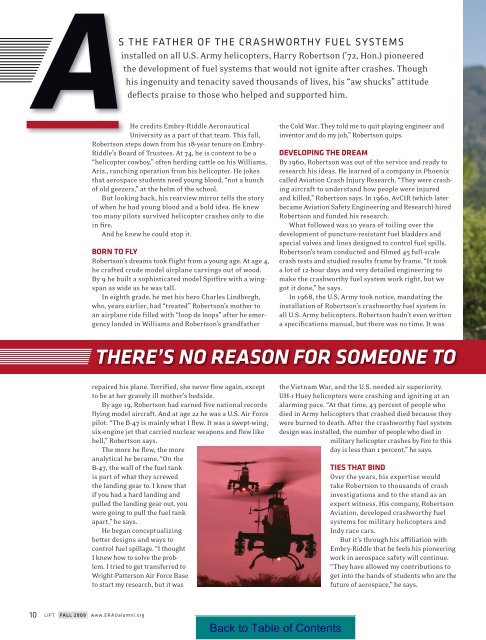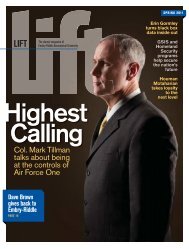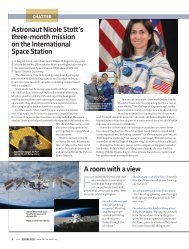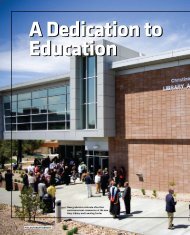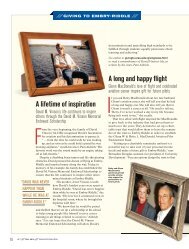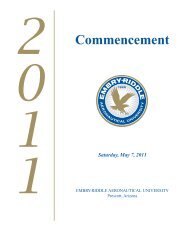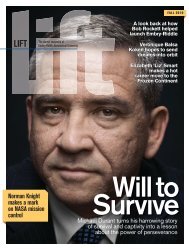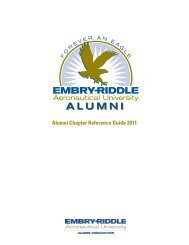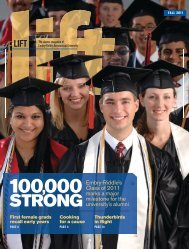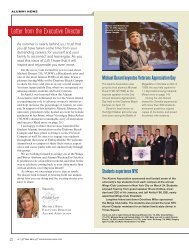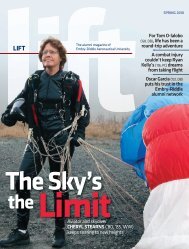Fall 2009 Issue - Embry-Riddle Aeronautical University Alumni
Fall 2009 Issue - Embry-Riddle Aeronautical University Alumni
Fall 2009 Issue - Embry-Riddle Aeronautical University Alumni
Create successful ePaper yourself
Turn your PDF publications into a flip-book with our unique Google optimized e-Paper software.
A<br />
S THE FATHER OF THE CRASHWORTHY FUEL SYSTEMS<br />
installed on all U.S. Army helicopters, Harry Robertson (’72, Hon.) pioneered<br />
the development of fuel systems that would not ignite after crashes. Though<br />
his ingenuity and tenacity saved thousands of lives, his “aw shucks” attitude<br />
deflects praise to those who helped and supported him.<br />
He credits <strong>Embry</strong>-<strong>Riddle</strong> <strong>Aeronautical</strong><br />
<strong>University</strong> as a part of that team. This fall,<br />
Robertson steps down from his 18-year tenure on <strong>Embry</strong>-<br />
<strong>Riddle</strong>’s Board of Trustees. At 74, he is content to be a<br />
“helicopter cowboy,” often herding cattle on his Williams,<br />
Ariz., ranching operation from his helicopter. He jokes<br />
that aerospace students need young blood, “not a bunch<br />
of old geezers,” at the helm of the school.<br />
But looking back, his rearview mirror tells the story<br />
of when he had young blood and a bold idea. He knew<br />
too many pilots survived helicopter crashes only to die<br />
in fire.<br />
And he knew he could stop it.<br />
BORN TO FLY<br />
Robertson’s dreams took flight from a young age. At age 4,<br />
he crafted crude model airplane carvings out of wood.<br />
By 9 he built a sophisticated model Spitfire with a wingspan<br />
as wide as he was tall.<br />
In eighth grade, he met his hero Charles Lindbergh,<br />
who, years earlier, had “treated” Robertson’s mother to<br />
an airplane ride filled with “loop de loops” after he emergency<br />
landed in Williams and Robertson’s grandfather<br />
the Cold War. They told me to quit playing engineer and<br />
inventor and do my job,” Robertson quips.<br />
DEVELOPING THE DREAM<br />
By 1960, Robertson was out of the service and ready to<br />
research his ideas. He learned of a company in Phoenix<br />
called Aviation Crash Injury Research. “They were crashing<br />
aircraft to understand how people were injured<br />
and killed,” Robertson says. In 1960, AvCIR (which later<br />
became Aviation Safety Engineering and Research) hired<br />
Robertson and funded his research.<br />
What followed was 10 years of toiling over the<br />
development of puncture-resistant fuel bladders and<br />
special valves and lines designed to control fuel spills.<br />
Robertson’s team conducted and filmed 45 full-scale<br />
crash tests and studied results frame by frame. “It took<br />
a lot of 12-hour days and very detailed engineering to<br />
make the crashworthy fuel system work right, but we<br />
got it done,” he says.<br />
In 1968, the U.S. Army took notice, mandating the<br />
installation of Robertson’s crashworthy fuel system in<br />
all U.S. Army helicopters. Robertson hadn’t even written<br />
a specifications manual, but there was no time. It was<br />
THERE’S NO REASON FOR SOMEONE TO<br />
repaired his plane. Terrified, she never flew again, except<br />
to be at her gravely ill mother’s bedside.<br />
By age 19, Robertson had earned five national records<br />
flying model aircraft. And at age 22 he was a U.S. Air Force<br />
pilot. “The B-47 is mainly what I flew. It was a swept-wing,<br />
six-engine jet that carried nuclear weapons and flew like<br />
hell,” Robertson says.<br />
The more he flew, the more<br />
analytical he became. “On the<br />
B-47, the wall of the fuel tank<br />
is part of what they screwed<br />
the landing gear to. I knew that<br />
if you had a hard landing and<br />
pulled the landing gear out, you<br />
were going to pull the fuel tank<br />
apart,” he says.<br />
He began conceptualizing<br />
better designs and ways to<br />
control fuel spillage. “I thought<br />
I knew how to solve the problem.<br />
I tried to get transferred to<br />
Wright-Patterson Air Force Base<br />
to start my research, but it was<br />
the Vietnam War, and the U.S. needed air superiority.<br />
UH-1 Huey helicopters were crashing and igniting at an<br />
alarming pace. “At that time, 43 percent of people who<br />
died in Army helicopters that crashed died because they<br />
were burned to death. After the crashworthy fuel system<br />
design was installed, the number of people who died in<br />
military helicopter crashes by fire to this<br />
day is less than 1 percent,” he says.<br />
TIES THAT BIND<br />
Over the years, his expertise would<br />
take Robertson to thousands of crash<br />
investigations and to the stand as an<br />
expert witness. His company, Robertson<br />
Aviation, developed crashworthy fuel<br />
systems for military helicopters and<br />
Indy race cars.<br />
But it’s through his affiliation with<br />
<strong>Embry</strong>-<strong>Riddle</strong> that he feels his pioneering<br />
work in aerospace safety will continue.<br />
“They have allowed my contributions to<br />
get into the hands of students who are the<br />
future of aerospace,” he says.<br />
10 LIFT FALL <strong>2009</strong> www.ERAUalumni.org


